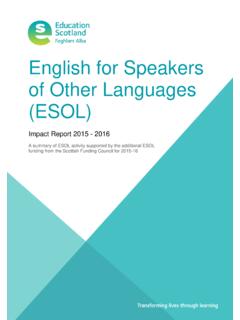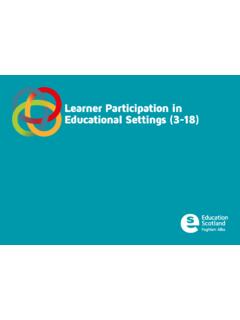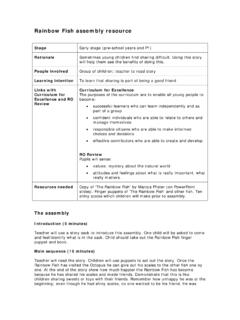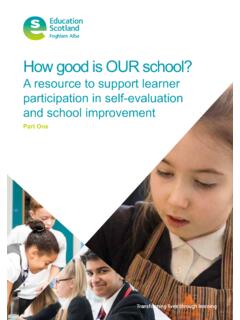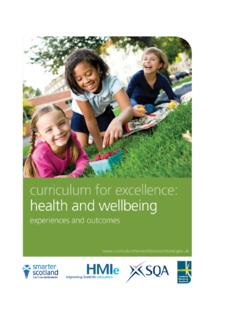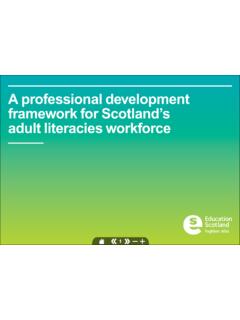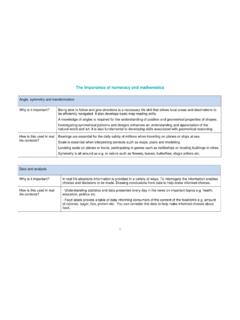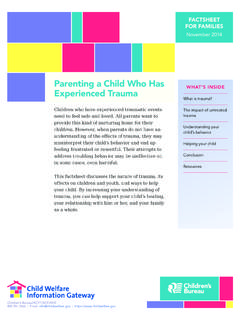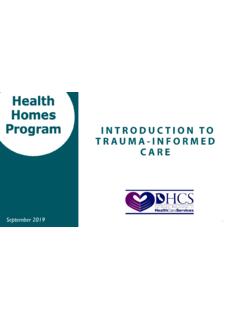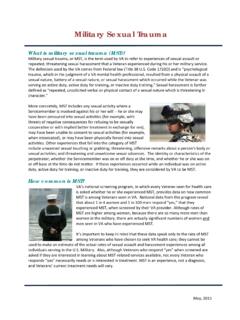Transcription of Nurture, Adverse Childhood Experiences and Trauma …
1 nurture , Adverse Childhood Experiences and Trauma informed practice: Making the links between these approaches Introduction/context Scottish education has a key focus on wellbeing and relationship-based approaches to support children and young people. An understanding of how early Experiences impact on children and young people s behaviour and the importance of relationships in shaping later outcomes is also the foundation which underpins much of the Scottish policy landscape and curriculum. Getting it Right for Every Child (GIRFEC) recognises that children and young people will have different Experiences in their lives, but that every child and young person has the right to expect appropriate support from adults to allow them to grow and develop and reach their full potential.
2 This is now enshrined in legislation in the Children and Young Person s (Scotland) Act (2014). The Adverse Childhood Experiences (ACEs) studyi which was initially published in the USA and later replicated in both Englandii and Wales,iii has recently had a renewed focus both internationally and within Scotland, in part due to the release of the film Resilience: The Biology of Stress and the Science of Hope. One of the core messages which has been emphasised within this research is the correlation between the number of Adverse Childhood Experiences an individual goes through and poor health and social outcomes in adulthood. It has long been recognised that stressful events occurring in Childhood can impact profoundly on children and young people s development and outcomes including the capacity to learn and participate in school life.
3 The increased interest in ACEs provides an opportunity to re-focus on the importance of Childhood development. One of the key theoretical frameworks which emphasises the importance of early Experiences and particularly the bond that an infant has with a caregiver is attachment Attachment theory forms a core part of a nurturing approach. At the heart of a nurturing approach is a focus on wellbeing and relationships and a drive to support the growth and development of children and young people particularly those who may have experienced early adversity or Trauma . Trauma informed approaches aim to promote an understanding of adversity and Trauma amongst those working with children and young people and the wider population.
4 This paper will bring together the key components of nurturing, ACEs and Trauma informed approaches before considering what commonalities and good practice exists across all approaches. It will also explore some of the challenges of embedding these approaches within an educational context. This paper is intended mainly for education practitioners however it may also be useful for a wider audience. A nurturing approach A nurturing approach can encompass both targeted support, eg. nurture Groups and universal support as in a whole school approach. nurture Groups were initially developed as an approach to supporting children who were believed to have missed some key early Experiences which impacted on their ability to settle and respond to school.
5 They were created by Marjory Boxall, an Educational Psychologist, in the 1960s in an inner city London borough as a means of bridging the gap between school and home and to help recreate these missed early Experiences through nurturing and supportive relationships. Over time, the original nurture Group concept has extended into a whole school approach which promotes nurturing and supportive relationships. A nurturing approach is based largely on the theory of attachment; an understanding of the impact of early adversity and how this can lead to toxic stress . Whilst a nurturing approach is based on an understanding of children s development, it also takes account of the current advances in neuroscience and brain development.
6 The theory of attachment originally stems from work by John Bowlby in the 1950s and later by Mary Ainsworth in the 1960s. Children display proximity seeking behaviours in order to get the attention of their caregiver and the caregivers response in those early interactions results in the child developing an attachment style that is either secure or insecure. This attachment relationship is important for future long-term outcomes where secure attachment is viewed as a protective factor which can enhance social and emotional well-being and insecure attachment is seen as a risk factor in relation to well-being. The key importance of attachment with adults has been well documented as a foundation for building resilience in young people and supporting their ability to engage in learning vi A further key feature of the nurturing approach is the focus on the 6 Nurturing Principlesvii which are outlined below.
7 Whole school and targeted approaches use these principles to guide practice. For example, in a nurturing classroom or nurture group, children are encouraged to create strong bonds that allow them to feel safe and explore their wider environment much as they would in a secure attachment relationship. Some of the key themesviii which are outlined in a nurturing approach are highlighted below. Research on nurture Groups has demonstrated benefits in social and emotional skills as well as x A range of evidence has also demonstrated the importance of some of the key features of a whole school nurturing approach, attachment to teachers has been shown to link strongly to behavior, attainment and other positive Consequently both nurture Groups and nurturing approaches have grown greatly in Scotland in the last twenty years and there are a number of key policy documents which advocate these xiii Research has also demonstrated that whole school approaches which support professional learning and policy development have a greater impact on wellbeing Education Scotland has also developed a resource entitled Applying nurture as a whole school approach: which is a framework to support the self-evaluation of nurturing approaches in schools and early learning and childcare settings.
8 Learning is understood developmentallyEnvironment offers a safe base nurture is important for wellbeing Language is a vital means of communication All behaviour is communication Transitions are important in children's lives Adverse Childhood Experiences (ACEs) The original ACEs study carried out between 1995 and 1997 surveyed 17,000 adults in the US asking them to complete a set of questions about Adverse Childhood Experiences and current health status and behaviours. An Adverse Childhood experience is a term given to describe all types of abuse, neglect and other traumatic Experiences that happen to individuals under the age of 18 years. Ten Adverse Childhood Experiences were identified.
9 In the original US study traumatic events were categorised into abuse, neglect and household dysfunction. It has since been recognised that a number of Adverse , potentially traumatic events were not included in the original ACES study including poverty, bereavement and bullying. Used with permission from the Scottish Government Results from this study indicated that ACEs are common, with almost two-thirds of the study participants reporting at least one ACE and more than 1 in 5 reporting three or more ACEs. Those with 4 or more ACEs were at greater risk of long term effects on health harming behaviours which leads to poorer outcomes in later life. In the UK there have been two ACE studies carried out in England and Wales both demonstrating strong links between early Adverse Experiences and poor health and social outcomes in adulthood.
10 While there has not been a Scottish ACE survey, a Scottish Public Health Network report, suggested that prevalence rates are likely to be similar to those reported in these studies. Used with permission from the Centers for Disease Control and Prevention 'Polishing the Diamonds' Addressing Adverse Childhood Experiences in Scotland provides an overview of ACEs and inequality, whilst Tackling the attainment gap by preventing and responding to Adverse Childhood Experiences (ACEs) provides further guidance for educators in tackling the attainment gap. There is also an increasing recognition of the links between Adverse Childhood Experiences , inequality and later offending behaviour as outlined in Reducing offending, reducing inequality.

